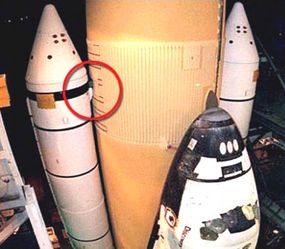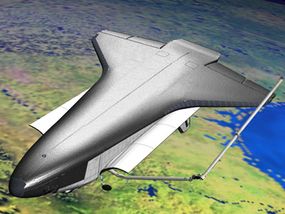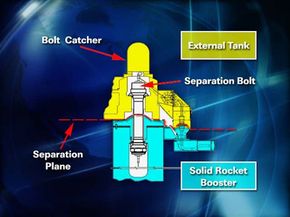Preventing Future Space Shuttle Disasters
Explosive bolts separate the SRBs from the external tank when the SRBs burn out in flight. Engineers assessed that fragments of the bolts could also damage the shuttle. They designed a bolt catcher to prevent the bolts from damaging the ET or hitting the orbiter.

To detect falling debris and possible damage to the shuttle, NASA has done the following:
Advertisement
- One hundred and seven cameras (Infrared, High Speed Digital Video, HDTV, 35 mm, 16 mm) have been placed on and around the launch pad to film the shuttle during liftoff.
- Ten sites within 40 miles of the launch pad have been equipped with cameras to film the shuttle during ascent.
- On days of heavier cloud cover when ground cameras will be obscured, two WB-57 aircraft will film the shuttle from high altitude as it ascends.
- Three radar tracking facilities (one with C-band and two with Doppler radar) will monitor the shuttle to detect debris.
- New digital video cameras have been installed on the ET to monitor the underside of the orbiter and relay the data to the ground through antennae installed in the ET.
- Cameras have been installed on the SRB noses to monitor the ET.
- The shuttle crew has new handheld digital cameras to photograph the ET after separation. The images will be downloaded to laptops on the orbiter and then transmitted to the ground.
- A digital spacewalk camera will be used for astronauts to inspect the orbiter while in orbit.
- Canada made a 50-foot long extension, called the Remote Manipulator System/Orbiter Booster Sensor System (RMS/OBSS), that can be attached to the robotic arm. This extension will allow the RMS to reach the underside of the orbiter. Cameras mounted on this extension will photograph the underside for damage.

Finally, engineers and technicians have installed 66 tiny accelerometers and 22 temperature sensors in the leading edge of both wings on the orbiter. The devices will detect the impact of any debris hitting the orbiter's wings.
The entire purpose of the imaging and wing sensors is to detect possible damage from falling debris. Engineers and administrators can analyze these images and make recommendations to the crew during the mission.
NASA also formulated ideas on how to repair damaged shuttles while in flight, including:
- Applying pre-ceramic polymers to small cracks
- Using small mechanical plugs made of carbon-silicone carbides to repair damage up to 6 inches in diameter
These ideas were tested aboard the shuttle Discovery in June 2005.
